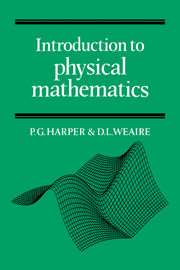Book contents
- Frontmatter
- Contents
- Preface
- Some notes on notation
- 1 Introduction
- 2 Errors
- 3 Cartesian coordinates
- 4 Vectors
- 5 The scalar product
- 6 The vector product and rotation
- 7 Matrices in physics
- 8 The transformation of matrices
- 9 The matrix eigenvalue equation
- 10 Exponential and logarithm functions
- 11 Sine and cosine functions
- 12 Graph plotting and curve sketching
- 13 Differentiation
- 14 Approximations
- 15 Power series and Taylor's expansion
- 16 Partial differentiation
- 17 Integration
- 18 The differential equation
- 19 Solving first-order differential equations
- 20 Second-order differential equations
- 21 Solving second-order differential equations
- 22 The complex exponential
- 23 The circuit equation
- 24 Harmonics and Fourier series
- 25 The diffusion equation
- 26 Waves
- 27 The rate of change of a vector
- 28 The scalar field and gradient operator
- 29 The vector field
- 30 Line integration
- 31 The potential field
- 32 Surface and volume integration
- 33 Flux and divergence
- 34 Circulation and the curl
- 35 Conclusion
- 36 Miscellaneous exercises
- Index
22 - The complex exponential
Published online by Cambridge University Press: 20 October 2009
- Frontmatter
- Contents
- Preface
- Some notes on notation
- 1 Introduction
- 2 Errors
- 3 Cartesian coordinates
- 4 Vectors
- 5 The scalar product
- 6 The vector product and rotation
- 7 Matrices in physics
- 8 The transformation of matrices
- 9 The matrix eigenvalue equation
- 10 Exponential and logarithm functions
- 11 Sine and cosine functions
- 12 Graph plotting and curve sketching
- 13 Differentiation
- 14 Approximations
- 15 Power series and Taylor's expansion
- 16 Partial differentiation
- 17 Integration
- 18 The differential equation
- 19 Solving first-order differential equations
- 20 Second-order differential equations
- 21 Solving second-order differential equations
- 22 The complex exponential
- 23 The circuit equation
- 24 Harmonics and Fourier series
- 25 The diffusion equation
- 26 Waves
- 27 The rate of change of a vector
- 28 The scalar field and gradient operator
- 29 The vector field
- 30 Line integration
- 31 The potential field
- 32 Surface and volume integration
- 33 Flux and divergence
- 34 Circulation and the curl
- 35 Conclusion
- 36 Miscellaneous exercises
- Index
Summary
For the practical physicist and engineer complex numbers provide a handy tool for the analysis of AC circuits. A few basic mathematical rules enable reactive circuit elements like inductances and capacitances to be treated with nothing more difficult than Ohm's law. The first-order linear equation (18.6), dealing with the voltage/current relationship in a simple LR circuit can be used to illustrate the benefits of the complex approach. We shall really just be repeating the steps which led us to (19.13) but we shall see them in a different light.
For generality it is helpful to regard the driving voltage as having both cos and sin components, expressed as A cos ωt – B sin ωt (the choice of sign is to comply with later conventions). Then the responding current also has both components and, following chapter 19, is written a cos ωt – b sin ωt. The mathematical object is then to calculate the coefficients a, b in terms of A, B by equating the driving voltage to the voltage fall across the elements L, R, as before.
Now the voltage change across the resistance is simply proportional to the current so that the cosine and sine oscillations of the voltage are the same, multiplied by R. In engineering terms this is the ‘quadrature response’. On the other hand the inductance requires a time differentiation which effectively exchanges the components (with a change of sign) to give the voltage fall – ωLa sin ωt – ωLb cos ωt.
Information
- Type
- Chapter
- Information
- Introduction to Physical Mathematics , pp. 153 - 158Publisher: Cambridge University PressPrint publication year: 1985
